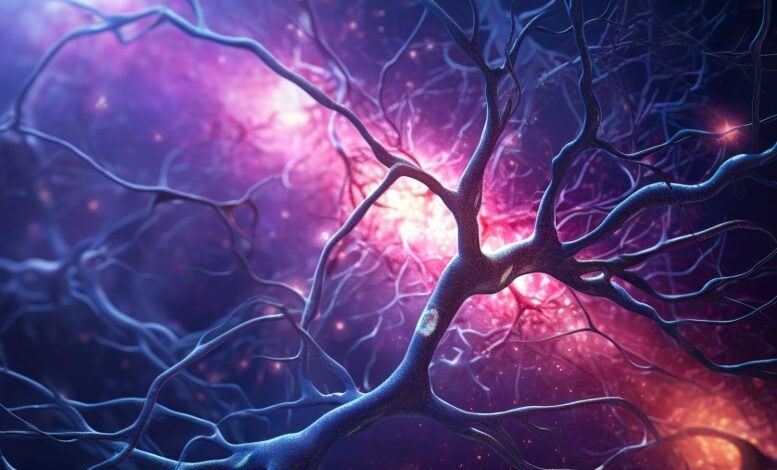

Johns Hopkins researchers have identified Aplp1 as a new biological target in Parkinson’s disease through mouse studies, showing its role in facilitating the spread of harmful alpha-synuclein proteins. They suggest that drugs targeting the interaction between Aplp1 and Lag3 could slow disease progression, with potential applications in other neurodegenerative diseases like Alzheimer’s. Credit: SciTechDaily.com
Johns Hopkins Medicine study finds targeting the Aplp1 and Lag3 interaction could slow the progression of Parkinson’s and potentially treat other neurodegenerative diseases.
Johns Hopkins Medicine researchers have discovered a new potential biological target for halting the spread of Parkinson’s disease-causing alpha-synuclein in studies with genetically engineered mice. They have identified Aplp1, a cell surface protein, as a key player in this process.
The findings, published May 31 in Nature Communications, reveal how Aplp1 connects with Lag3, another cell surface receptor, in a key part of a process that helps spread harmful alpha-synuclein proteins to brain cells. Those protein buildups are hallmarks of Parkinson’s disease.
Notably, the researchers say, Lag3 is already the target of a combination cancer drug approved by the U.S. Food and Drug Administration (FDA) that uses antibodies to “teach” the human immune system what to seek and destroy.
“Now that we know how Aplp1 and Lag3 interact, we have a new way of understanding how alpha-synuclein contributes to the disease progression of Parkinson’s disease,” says Xiaobo Mao, Ph.D., associate professor of neurology at the Johns Hopkins University School of Medicine and a member of the Institute for Cell Engineering. “Our findings also suggest that targeting this interaction with drugs could significantly slow the progression of Parkinson’s disease and other neurodegenerative diseases.”
Mao co-led the research along with Ted Dawson, M.D., Ph.D., Leonard and Madlyn Abramson Professor in Neurodegenerative Diseases at the Johns Hopkins University School of Medicine and director of the Johns Hopkins Institute for Cell Engineering, Valina Dawson, Ph.D. and Hanseok Ko, Ph.D., professors of neurology at the school of medicine and members of the Institute for Cell Engineering.
Existing Research and Findings
Long-standing studies have shown that by clumping together and forming protein deposits, misfolded alpha-synuclein proteins journey from brain cell to brain cell, killing those responsible for producing a neurotransmitter called dopamine, and causing Parkinson’s disease to progress through a type of “programmed” cell death that Johns Hopkins researchers have identified. The process, parthanatos (from the Greek word for “death”), leads to impairments in movement, emotional regulation and thinking.
Aplp1’s bond with Lag3 on the cell’s surface enables healthy brain cells to absorb traveling clumps of alpha-synuclein, leading to cell death, the researchers say.

Neurons express Aplp1 (in white), a key protein that allows brain cells to absorb Parkinson’s-disease causing alpha-synuclein. Credit: Yasuyoshi Kimura, Ph.D.
In mouse studies published in 2016 and 2021, Mao and Dawson’s team identified Lag3’s role in binding with alpha-synuclein proteins, causing Parkinson’s disease to spread. However, those studies indicated that another protein was partially responsible for the cell’s absorption of misfolded alpha-synuclein.
“Our work previously demonstrated that Lag3 wasn’t the only cell surface protein that helped neurons absorb alpha-synuclein, so we turned to Aplp1 in our most recent experiments,” says Valina Dawson.
Recent Experimental Insights
To determine whether Aplp1 indeed contributed to the spread of harmful alpha-synuclein proteins, researchers used a line of genetically engineered mice lacking either Aplp1 or Lag3 or both Aplp1 and Lag3. In mice without Aplp1 and Lag3, cell absorption of the harmful alpha-synuclein protein dropped by 90%. After injecting mice with the Lag3 antibody, they found that this drug also blocks the interaction of Aplp1 and Lag3, meaning healthy brain cells could no longer absorb disease-causing alpha-synuclein clumps.
The researchers say the Lag3 antibody nivolumab/relatlimab, a drug FDA approved in 2022 for cancer treatment, could play a role in preventing cells from absorbing alpha-synuclein.
“The anti-Lag3 antibody was successful in preventing further spread of alpha-synuclein seeds in the mouse models and exhibited better efficacy than Lag3-depletion because of Aplp1’s close association with Lag3,” Ted Dawson says.
This research has potential applications in treating other neurodegenerative conditions that have no cures, Mao says. In Alzheimer’s disease, which is associated with symptoms of memory loss, mood instability, and muscle problems, tau proteins become misfolded and clump together in neurons at high levels, worsening the condition. In Alzheimer’s research, Mao says scientists could try to target Lag3 — which also binds with the dementia-related tau protein — with the same antibody.
With the success of using the Lag3 antibody in mice, Ted Dawson says the next steps would be to conduct anti-Lag3 antibody trials in mice with Parkinson’s disease and Alzheimer’s disease. The Johns Hopkins researchers are also looking into how they could prevent unhealthy cells from releasing disease-causing alpha-synuclein in the first place.
Reference: “Aplp1 interacts with Lag3 to facilitate transmission of pathologic α-synuclein” by Xiaobo Mao, Hao Gu, Donghoon Kim, Yasuyoshi Kimura, Ning Wang, Enquan Xu, Ramhari Kumbhar, Xiaotian Ming, Haibo Wang, Chan Chen, Shengnan Zhang, Chunyu Jia, Yuqing Liu, Hetao Bian, Senthilkumar S. Karuppagounder, Fatih Akkentli, Qi Chen, Longgang Jia, Heehong Hwang, Su Hyun Lee, Xiyu Ke, Michael Chang, Amanda Li, Jun Yang, Cyrus Rastegar, Manjari Sriparna, Preston Ge, Saurav Brahmachari, Sangjune Kim, Shu Zhang, Yasushi Shimoda, Martina Saar, Haiqing Liu, Sin Ho Kweon, Mingyao Ying, Creg J. Workman, Dario A. A. Vignali, Ulrike C. Muller, Cong Liu, Han Seok Ko, Valina L. Dawson and Ted M. Dawson, 31 May 2024, Nature Communications.
DOI: 10.1038/s41467-024-49016-3
Other researchers on this study are Hao Gu, Donghoon Kim, Yasuyoshi Kimura, Ning Wang, Enquan Xu, Ramhari Kumbhar, Xiaotian Ming, Haibo Wang, Chan Chen, Shengnan Zhang, Chunyu Jia, Yuqing Liu, Hetao Bian, Senthilkumar Karuppagounder, Fatih Akkentli, Qi Chen, Longgang Jia, Heehong Hwang, Su Hyun Lee, Xiyu Ke, Michael Chang, Amanda Li, Jun Yang, Cyrus Rastegar, Manjari Sriparna, Preston Ge, Saurav Brahmachari, Sangjune Kim, Shu Zhang, Haiqing Liu, Sin Ho Kweon, Mingyao Ying and Han Seok Ko from Johns Hopkins; Yasushi Shimoda from the Nagaoka University of Technology; Martina Saar and Ulrike Muller from Heidelberg University; Creg Workman and Dario Vignali of the University of Pittsburgh School of Medicine and Cong Liu of the Chinese Academy of Sciences.
This work was supported by grants from the National Institutes of Health (R01NS107318, R01AG073291, R01AG071820, 1135 RF1NS125592, K01AG056841, R21NS125559, R01NS107404, P01AI108545, R01AI144422), the Parkinson’s Foundation, the Maryland Stem Cell Research Foundation, the American Parkinson Disease Association, the Uehara Memorial Foundation, the JPB Foundation, the Adrienne Helis Malvin Medical Research Foundation, and the Parkinson’s Disease Foundation.



